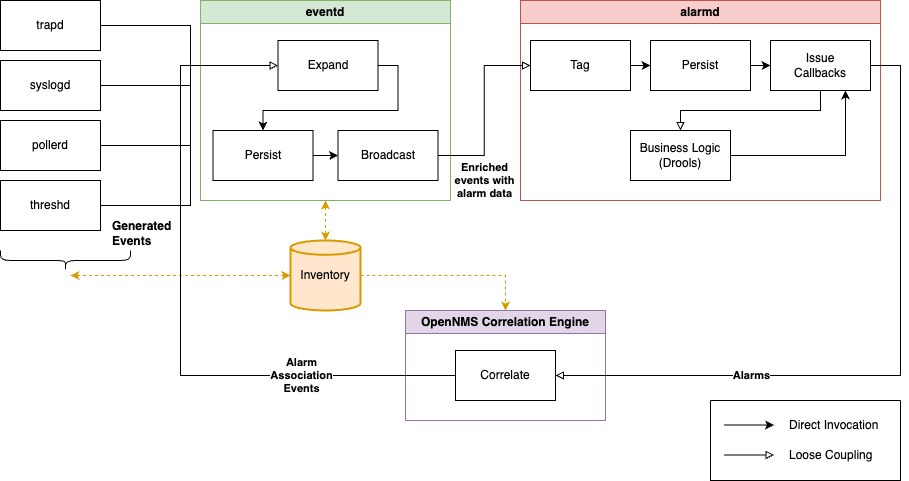OpenNMS Integration
The lifecycle of an alarm and the correlation process between OpenNMS and ALEC involves various components:

Existing OpenNMS services that process unsolicited messages or actively poll monitored network inventory also generate events. Eventd processes and enriches these messages with the corresponding configuration data.
Alarmd listens for events that contain alarm metadata and, when it identifies them, creates or updates corresponding alarms. It also exposes a series of event hooks that can be used to alter or enrich alarms when they are created. ALEC leverages these hooks to perform additional data processing and tag alarms with a managed object type and managed object instance (see Managed object tagging). OpenNMS can also generate notifications when alarms are modified in any way.
The direct datasource leverages API hooks within the runtime, whereas the Kafka datasource leverages the Kafka integration to interface externally.
Managed object tagging
Managed object tagging further contextualizes alarms by associating them with a specific component instance or inventory object in ALEC. The process is flexible and configurable, allowing alarms to be associated with components beyond the existing node, interface, service model that is built into OpenNMS.
Example
Assume that OpenNMS captures the following syslog message:
%CDP-4-DUPLEX_MISMATCH: duplex mismatch discovered on ge1/1 (not half duplex), with sw-blue ge1/2 (half duplex).Syslogd can generate an event from the message using the following match:
<ueiMatch>
<match type="regex" expression="%CDP-4-DUPLEX_MISMATCH\s*: duplex mismatch discovered on (\S+) \((.+)\), with (\S+) (\S+) \((.+)\)" />
<uei>uei.opennms.org/vendor/cisco/syslog/duplexMismatch</uei>
<parameter-assignment matching-group="1" parameter-name="aIfDescr" />
<parameter-assignment matching-group="2" parameter-name="aDuplex" />
<parameter-assignment matching-group="3" parameter-name="zHostname" />
<parameter-assignment matching-group="4" parameter-name="zIfDescr" />
<parameter-assignment matching-group="5" parameter-name="zDuplex" />
</ueiMatch>After the event is generated, it can be defined using the following properties:
<event>
<uei>uei.opennms.org/vendor/cisco/syslog/duplexMismatch</uei>
<event-label>CISCO defined syslog event: duplexMismatch</event-label>
<descr>The duplex %parm[aIfDescr]% is set to %parm[aDuplex]% which
does not match %parm[zDuplex]% on %parm[zHostname]% %parm[zIfDescr]%.
</descr>
<logmsg dest="logndisplay">Duplex mismatch on %parm[aIfDescr]% (%parm[aDuplex]% vs %parm[zDuplex]%)</logmsg>
<severity>Warning</severity>
<alarm-data reduction-key="%uei%:%dpname%:%nodeid%:%parm[aIfDescr]%" alarm-type="3">
<managed-object type="snmp-interface-link"/>
</alarm-data>
</event>The event triggers a type 3 alarm (trigger with no associated clear) and specifies the managed object type (snmp-interface-link).
The Model reference chapter shows that this managed object type requires the following tokens:
-
aIfDescr -
zIfDescr -
zHostname
All of these tokens are automatically extracted and converted into event parameters.
When an alarm is created, ManagedObjectAlarmExt is triggered.
It will resolve and convert the event data as appropriate.
In this case, it searches for a node whose label is the same as zHostname and tries to find the ifIndex value for SNMP interfaces with the given ifDescr values.
The managed object instance is then updated to include any resolved attributes.
When ALEC receives the tagged alarm, the alarm contains enough information that it can be reliably attached to a corresponding inventory object.